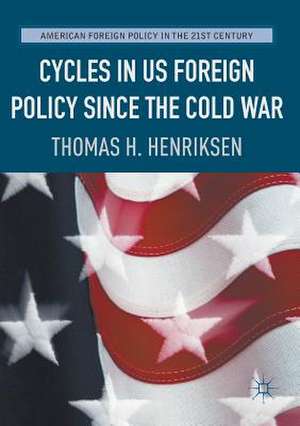Cycles in US Foreign Policy since the Cold War: American Foreign Policy in the 21st Century
Autor Thomas H. Henriksenen Limba Engleză Paperback – 3 mai 2018
| Toate formatele și edițiile | Preț | Express |
|---|---|---|
| Paperback (1) | 269.81 lei 43-57 zile | |
| Springer International Publishing – 3 mai 2018 | 269.81 lei 43-57 zile | |
| Hardback (1) | 588.18 lei 43-57 zile | |
| Springer International Publishing – feb 2017 | 588.18 lei 43-57 zile |
Preț: 269.81 lei
Nou
Puncte Express: 405
Preț estimativ în valută:
51.63€ • 54.05$ • 42.72£
51.63€ • 54.05$ • 42.72£
Carte tipărită la comandă
Livrare economică 07-21 aprilie
Preluare comenzi: 021 569.72.76
Specificații
ISBN-13: 9783319748528
ISBN-10: 3319748521
Pagini: 332
Ilustrații: XI, 332 p.
Dimensiuni: 148 x 210 x 20 mm
Greutate: 0.41 kg
Ediția:1st ed. 2017
Editura: Springer International Publishing
Colecția Palgrave Macmillan
Seria American Foreign Policy in the 21st Century
Locul publicării:Cham, Switzerland
ISBN-10: 3319748521
Pagini: 332
Ilustrații: XI, 332 p.
Dimensiuni: 148 x 210 x 20 mm
Greutate: 0.41 kg
Ediția:1st ed. 2017
Editura: Springer International Publishing
Colecția Palgrave Macmillan
Seria American Foreign Policy in the 21st Century
Locul publicării:Cham, Switzerland
Cuprins
Introduction.- George Herbert Walker Bush: A Disorderly World Put Right.- George H.W. Bush: Interventionism Unbound.- William Jefferson Clinton: The Post-Cold War’s Inward Look.- Bill Clinton and Two Reluctant Interventions into the Balkans.- George Walker Bush and the International Outreach.- George W. Bush’s Overstretch Abroad.- Barack Hussein Obama and the New Retrenchment.- Barack Obama: A Foreign Policy of Disengagement .- Observations on the Cycles in U.S. Foreign Policy.
Recenzii
“Cycles in US Foreign Policy Since the Cold War is a significant contribution to the literature and an essential reference for policymakers and academics interested in U.S. foreign policy and international relations. All things considered, anyone who is interested in U.S. policies may find this book interesting.” (Çağatay Özdemir,Insight Turkey, Vol. 21 (2), 2019)
Notă biografică
Thomas H. Henriksen is Senior Fellow at Hoover Institution, Stanford University, USA. Henriksen is the author of America and the Rogue States (2012) and American Power after the Berlin Wall (2007) as well as many other books and articles.
Textul de pe ultima copertă
This book describes how American international policy alternates between engagement and disengagement cycles in world affairs. These cycles provide a unique way to understand, assess, and describe fluctuations in America’s involvement or non-involvement overseas. In addition to its basic thesis, the book presents a fair-minded account of four presidents’ foreign policies in the post-Cold War period: George H.W. Bush, Bill Clinton, George W. Bush, and Barack Obama. It suggests recurring sources of cyclical change, along with implications for the future. An engaged or involved foreign policy entails the use of military power and diplomatic pressure against other powers to secure American ends. A disengaged or noninvolved policy relies on normal economic and political interaction with other states, which seeks to disassociate from entanglements.
Caracteristici
Offers a unique way of looking at American foreign policy after the collapse of the Berlin Wall Identifies and explains swings between engagement and disengagement in recent US foreign policy Provides a survey of American foreign policy since the end of the Cold War through the lens of different presidencies Suggests future implications of these sources of cyclical change in US foreign policy



